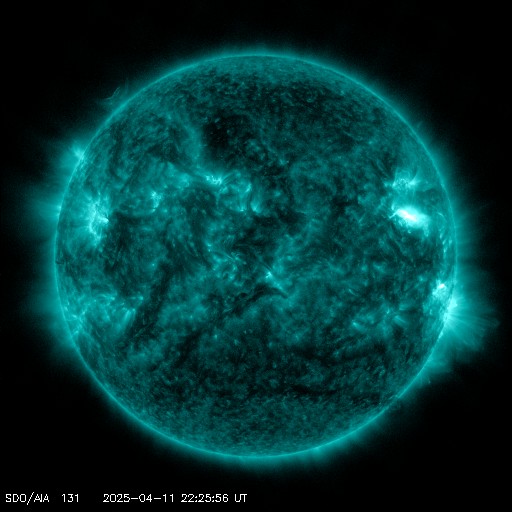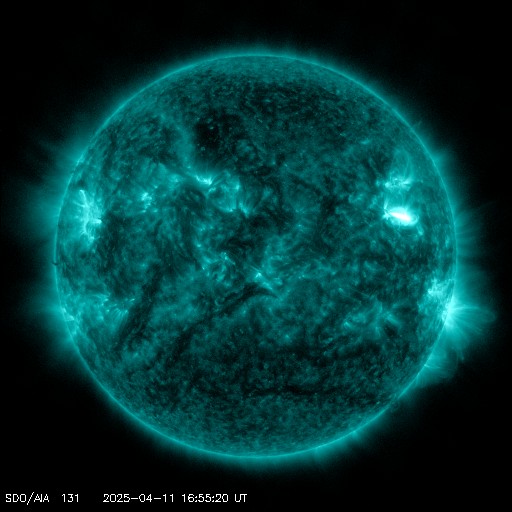Viewing archive of Thursday, 1 November 2001
Solar activity report
Any mentioned solar flare in this report has a scaling factor applied by the Space Weather Prediction Center (SWPC). Because of the SWPC scaling factor, solar flares are reported as 42% smaller than for the science quality data. The scaling factor has been removed from our archived solar flare data to reflect the true physical units.
Report of Solar-Geophysical Activity 2001 Nov 01 2200 UTCPrepared by the NOAA © SWPC and processed by SpaceWeatherLive.com
Joint USAF/NOAA Report of Solar and Geophysical Activity
SDF Number 305 Issued at 2200Z on 01 Nov 2001IA. Analysis of Solar Active Regions and Activity from 31-2100Z to 01-2100Z
Solar activity has been high due to five M-class events
observed during the past 24 hours. The largest of these was an M3/Sf
at 1210 UTC from newly numbered Region 9687 (S19E71). Region 9687
produced three additional M-class events and exhibited frequent
brightenings throughout the day. An additional M-class event (M1/Sf)
came from Region 9678 (N07W75) at 0653 UTC. Region 9682 (N11W22)
continues to dominate the disk in terms of apparent size and
magnetic complexity, and also exhibited occasional flare activity
during the day, some of which were occurring at the same time as
flare activity in Region 9687. SXI imagery clearly indicated,
however, that new Region 9687 was the dominant contributor to the
X-ray flux during the four M-class events mentioned previously.
IB. Solar Activity Forecast
Solar activity is expected to be
moderate to high. M-class events should continue, with regions 9687
and 9682 being the main contributors to activity. There continues to
be a chance for an isolated major flare event or proton producing
event during the next three days.
IIA. Geophysical Activity Summary 31-2100Z to 01-2100Z
The geomagnetic field ranged from unsettled to minor storm levels
during the past 24 hours. Approximately five hours after yesterday's
shock at 31/1352 UTC, the interplanetary magnetic field turned
southward and maintained moderately strong negative values (-8 to
-12 nT) from 31/1810 UTC until around 01/1710 UTC. This led to
mostly active levels, with a minor storm period from 0600-0900 UTC.
At forecast issue time activity had declined to unsettled and Bz was
weakly northwards.
IIB. Geophysical Activity Forecast
The geomagnetic field is
expected to be mostly unsettled for the next three days.
III. Event Probabilities 02 Nov to 04 Nov
| Class M | 90% | 90% | 90% |
| Class X | 25% | 25% | 25% |
| Proton | 20% | 20% | 20% |
| PCAF | yellow | ||
IV. Penticton 10.7 cm Flux
Observed 01 Nov 236 Predicted 02 Nov-04 Nov 225/225/230 90 Day Mean 01 Nov 204
V. Geomagnetic A Indices
Observed Afr/Ap 31 Oct 008/009 Estimated Afr/Ap 01 Nov 025/025 Predicted Afr/Ap 02 Nov-04 Nov 012/012-012/010-010/010
VI. Geomagnetic Activity Probabilities 02 Nov to 04 Nov
| A. Middle Latitudes | |||
|---|---|---|---|
| Active | 25% | 25% | 20% |
| Minor storm | 15% | 15% | 15% |
| Major-severe storm | 05% | 05% | 05% |
| B. High Latitudes | |||
|---|---|---|---|
| Active | 25% | 25% | 20% |
| Minor storm | 15% | 15% | 15% |
| Major-severe storm | 10% | 10% | 05% |
All times in UTC
Current data suggests there is a slight possibility for aurora to appear at the following high latitude regions in the near future
Gillam, MBLatest news
Latest forum messages
More topicsSupport SpaceWeatherLive.com!
A lot of people come to SpaceWeatherLive to follow the Sun's activity or if there is aurora to be seen, but with more traffic comes higher server costs. Consider a donation if you enjoy SpaceWeatherLive so we can keep the website online!

Latest alerts
Friday, 11 April 2025
22:39 UTC - Solar flare
Moderate M1.05 flare
22:24 UTC - Hemispheric Power Index
The OVATION model predicts the Hemispheric Power Index to reach 50GW at 23:16 UTC
22:24 UTC - Radio Blackout
Minor R1 radio blackout in progress (≥M1 - current: M1.05)
17:09 UTC - Solar flare
Moderate M1.08 flare
16:51 UTC - Radio Blackout
Minor R1 radio blackout in progress (≥M1 - current: M1.04)
Space weather facts
| Last X-flare | 2025/03/28 | X1.1 |
| Last M-flare | 2025/04/11 | M1.0 |
| Last geomagnetic storm | 2025/04/06 | Kp5 (G1) |
| Spotless days | |
|---|---|
| Last spotless day | 2022/06/08 |
| Monthly mean Sunspot Number | |
|---|---|
| March 2025 | 134.2 -20.4 |
| April 2025 | 141.4 +7.2 |
| Last 30 days | 137.1 -3 |




